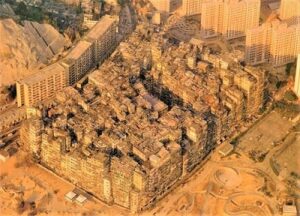Kowloon Walled City was a largely ungoverned and overpopulated settlement, part of present-day Kowloon in the region of Hong Kong. Originally a military fort of the Qing dynasty, the walled city became a Chinese enclave after the New Territories were leased to the United Kingdom in 1898 from China, excluding the fortified portion.
Its population increased dramatically following the Japanese occupation of Hong Kong during World War II. In 1990 the walled city contained an estimated 50,000 residents within its 2.6 hectares (0.026 km² ) boundaries.
From 1950 to 1970, it was subject to near-total control of the local triads with high rates of prostitution, gambling, and drug abuse. In January 1987 the Hong Kong government announced plans to demolish the walled city.
After an arduous eviction process, demolition began in March 1993 and was completed in April 1994. In December 1995, the “Kowloon Walled City Park” was inaugurated and now occupies the area of the former walled city.
Some historical artifacts of the walled city, including its yamen building and remains of its south gate, have been preserved there.

Kowloon Walled City Facts
- Settled: c. 1898
- Demolished: 1994
- Total Area: 2.6 ha (6.4 acres)
- Country/City:
China (de facto 1898-1912; de jure; 1898–1993)
British Hong Kong (de facto; 1912–1993; sovereignty 1993–1997) - District: Kowloon City District
- Area: Kowloon City
- Population: 50,000 (1990)
Kowloon Walled City History
The Citadel, known as Kowloon when it was first established, was established during the Song Dynasty (960–1279) when it served as the region’s observation post against pirates and as a center for the management of salt production.
It was rebuilt as a fortress in the middle of the 19th century on the same site. After the cession of Hong Kong Island to the British in 1842 (Nanjing Treaty), the Chinese imperial authorities deemed it necessary to establish a military observation post to dominate the peninsula and periodically check for possible expansion of English influence in the area.
In 1898, a Convention was signed that transferred other portions of the Chinese territory of Hong Kong to the English, for an additional 99 years. The Convention excluded the Kowloon Citadel (then with a population of around 700 people), which remained in the domain of China, which could maintain troops on the peninsula, provided they did not interfere with English activities.
The English Crown soon disregarded this part of the agreement, attacking Kowloon in 1899, but finding it completely deserted. Nothing was done with the Citadel and the question of its ownership was left in the background.
Around 1940, the Citadel became a highly populated neighborhood, all concentrated within its walls. The enclave remained part of Chinese territory despite China’s intense political changes (fall of the Qing Dynasty, the establishment of the Republic, and, finally, the advent of Communism)
The citadel remained a curiosity and a tourist attraction for English settlers and tourists, who could feel, visiting its alleys, as was China of ancient times. With the occupation of Hong Kong in 1940, during the Second World War, the Empire of Japan evacuated the citadel and demolished it almost completely (including its walls), in order to obtain building materials for military works.
After the Japanese surrender, the citadel resisted several English attacks, until 1948, for them to vacate it. With no walls to protect it, Kowloon became a safe haven for bandits, robbers, and opium addicts, as Hong Kong police had no right to enter the Citadel and mainland China refused to address the issue.
With the def initive establishment of Chinese Communism in 1949, thousands of refugees (predominantly from Canton) emigrated to Kowloon. The English Crown was already fed up and started to adopt a more interventionist position in the Citadel.


